Cultural and Social Diversity in Healthcare
VerifiedAdded on 2023/06/07
|12
|3547
|421
AI Summary
This article discusses the social and health-related risk factors associated with Christianity and Hinduism cultures. It explores the strategies for the provision of healthcare for these cultures, including community assessment and monitoring, risk reduction counselling, and improved induction training. The article also highlights the importance of diversity in the design of healthcare frameworks and services.
Contribute Materials
Your contribution can guide someone’s learning journey. Share your
documents today.
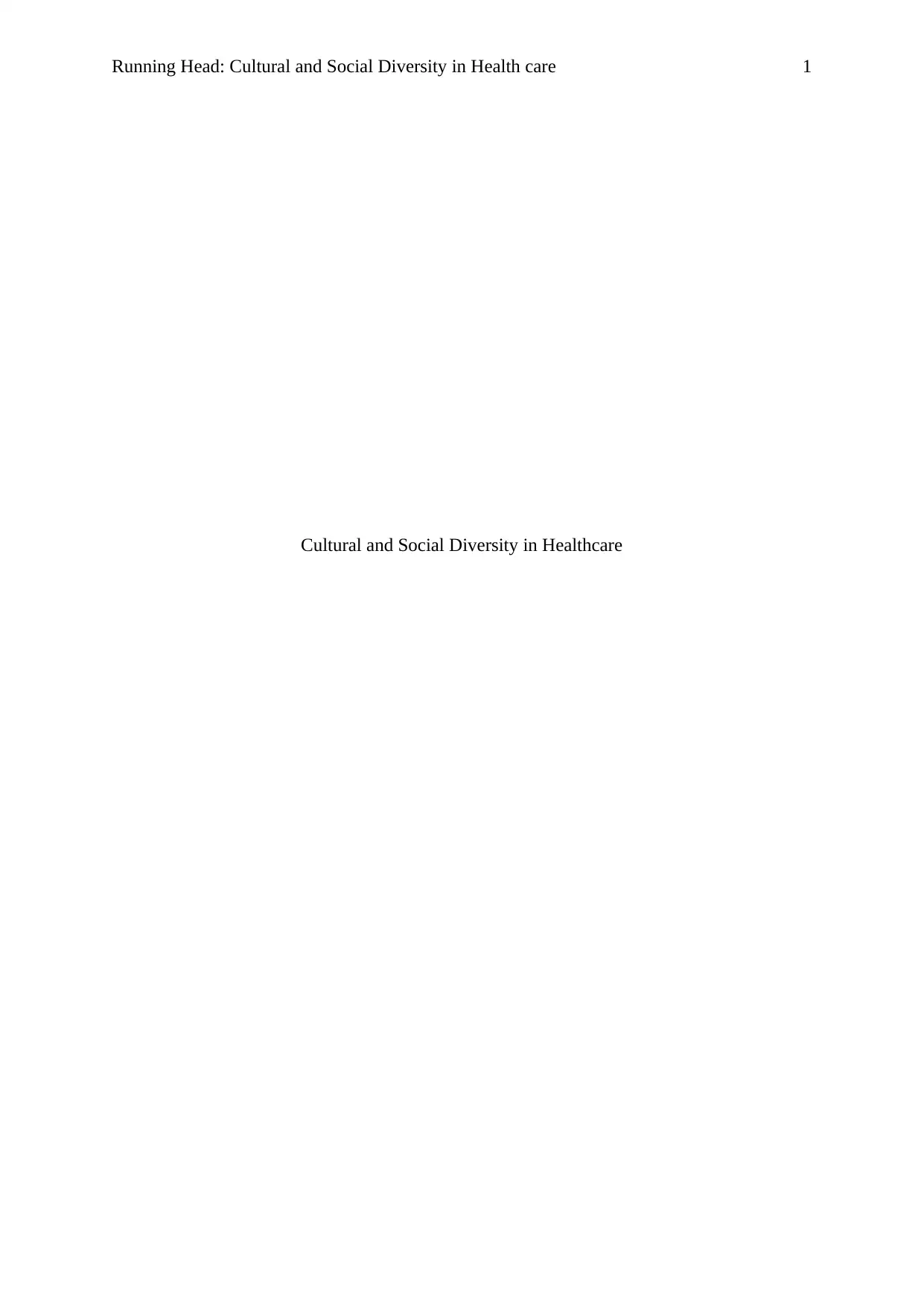
Running Head: Cultural and Social Diversity in Health care 1
Cultural and Social Diversity in Healthcare
Cultural and Social Diversity in Healthcare
Secure Best Marks with AI Grader
Need help grading? Try our AI Grader for instant feedback on your assignments.
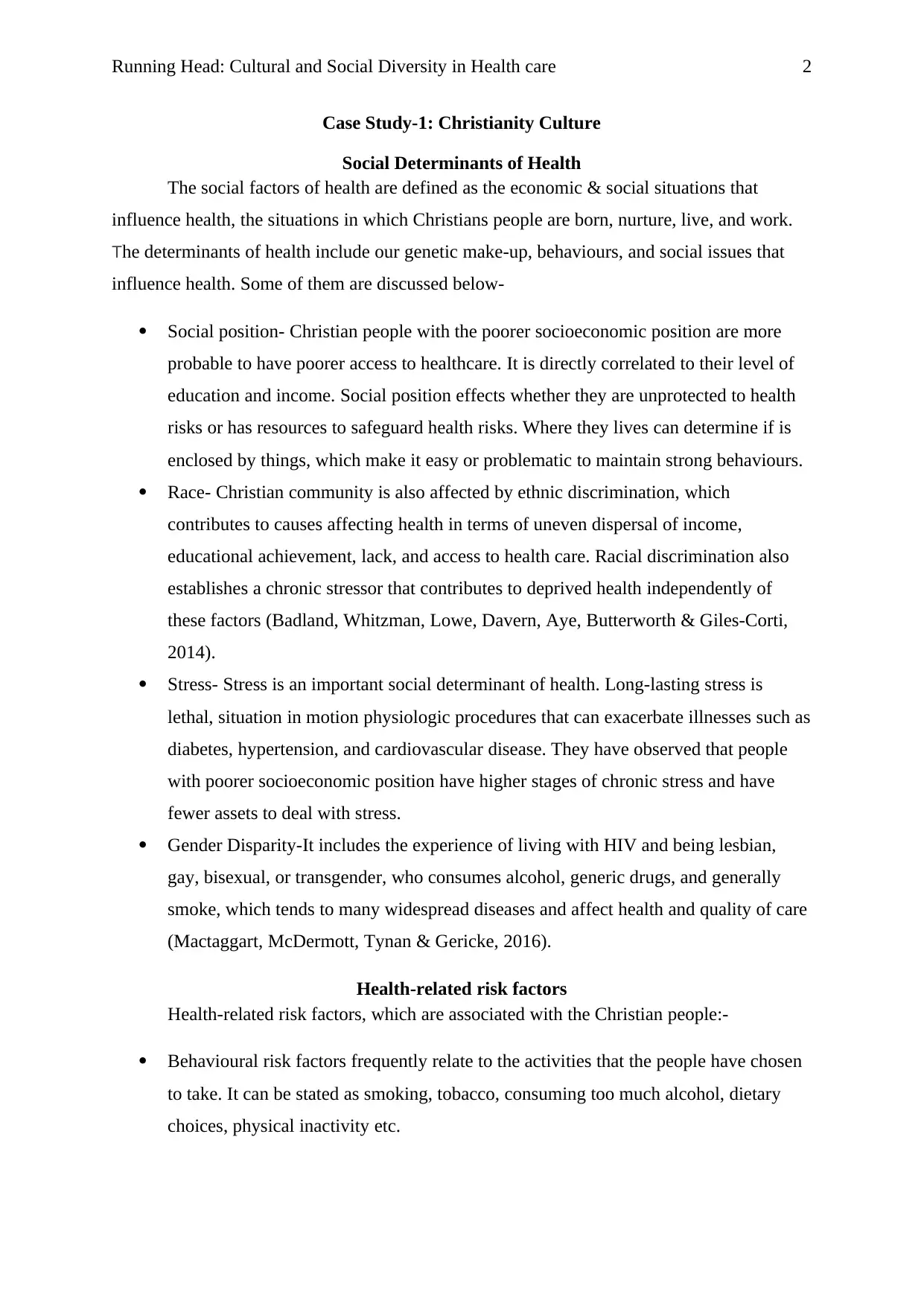
Running Head: Cultural and Social Diversity in Health care 2
Case Study-1: Christianity Culture
Social Determinants of Health
The social factors of health are defined as the economic & social situations that
influence health, the situations in which Christians people are born, nurture, live, and work.
The determinants of health include our genetic make-up, behaviours, and social issues that
influence health. Some of them are discussed below-
Social position- Christian people with the poorer socioeconomic position are more
probable to have poorer access to healthcare. It is directly correlated to their level of
education and income. Social position effects whether they are unprotected to health
risks or has resources to safeguard health risks. Where they lives can determine if is
enclosed by things, which make it easy or problematic to maintain strong behaviours.
Race- Christian community is also affected by ethnic discrimination, which
contributes to causes affecting health in terms of uneven dispersal of income,
educational achievement, lack, and access to health care. Racial discrimination also
establishes a chronic stressor that contributes to deprived health independently of
these factors (Badland, Whitzman, Lowe, Davern, Aye, Butterworth & Giles-Corti,
2014).
Stress- Stress is an important social determinant of health. Long-lasting stress is
lethal, situation in motion physiologic procedures that can exacerbate illnesses such as
diabetes, hypertension, and cardiovascular disease. They have observed that people
with poorer socioeconomic position have higher stages of chronic stress and have
fewer assets to deal with stress.
Gender Disparity-It includes the experience of living with HIV and being lesbian,
gay, bisexual, or transgender, who consumes alcohol, generic drugs, and generally
smoke, which tends to many widespread diseases and affect health and quality of care
(Mactaggart, McDermott, Tynan & Gericke, 2016).
Health-related risk factors
Health-related risk factors, which are associated with the Christian people:-
Behavioural risk factors frequently relate to the activities that the people have chosen
to take. It can be stated as smoking, tobacco, consuming too much alcohol, dietary
choices, physical inactivity etc.
Case Study-1: Christianity Culture
Social Determinants of Health
The social factors of health are defined as the economic & social situations that
influence health, the situations in which Christians people are born, nurture, live, and work.
The determinants of health include our genetic make-up, behaviours, and social issues that
influence health. Some of them are discussed below-
Social position- Christian people with the poorer socioeconomic position are more
probable to have poorer access to healthcare. It is directly correlated to their level of
education and income. Social position effects whether they are unprotected to health
risks or has resources to safeguard health risks. Where they lives can determine if is
enclosed by things, which make it easy or problematic to maintain strong behaviours.
Race- Christian community is also affected by ethnic discrimination, which
contributes to causes affecting health in terms of uneven dispersal of income,
educational achievement, lack, and access to health care. Racial discrimination also
establishes a chronic stressor that contributes to deprived health independently of
these factors (Badland, Whitzman, Lowe, Davern, Aye, Butterworth & Giles-Corti,
2014).
Stress- Stress is an important social determinant of health. Long-lasting stress is
lethal, situation in motion physiologic procedures that can exacerbate illnesses such as
diabetes, hypertension, and cardiovascular disease. They have observed that people
with poorer socioeconomic position have higher stages of chronic stress and have
fewer assets to deal with stress.
Gender Disparity-It includes the experience of living with HIV and being lesbian,
gay, bisexual, or transgender, who consumes alcohol, generic drugs, and generally
smoke, which tends to many widespread diseases and affect health and quality of care
(Mactaggart, McDermott, Tynan & Gericke, 2016).
Health-related risk factors
Health-related risk factors, which are associated with the Christian people:-
Behavioural risk factors frequently relate to the activities that the people have chosen
to take. It can be stated as smoking, tobacco, consuming too much alcohol, dietary
choices, physical inactivity etc.
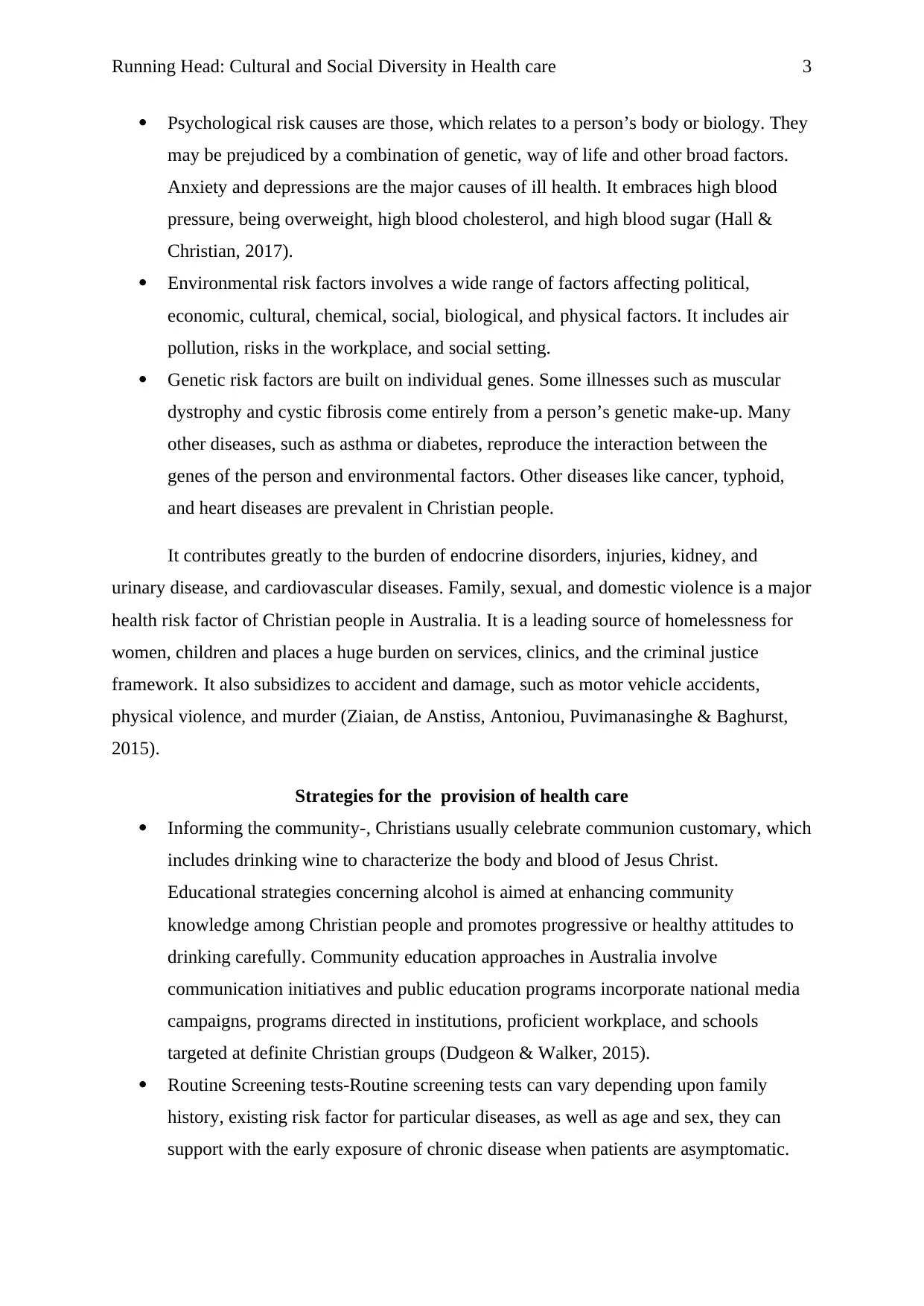
Running Head: Cultural and Social Diversity in Health care 3
Psychological risk causes are those, which relates to a person’s body or biology. They
may be prejudiced by a combination of genetic, way of life and other broad factors.
Anxiety and depressions are the major causes of ill health. It embraces high blood
pressure, being overweight, high blood cholesterol, and high blood sugar (Hall &
Christian, 2017).
Environmental risk factors involves a wide range of factors affecting political,
economic, cultural, chemical, social, biological, and physical factors. It includes air
pollution, risks in the workplace, and social setting.
Genetic risk factors are built on individual genes. Some illnesses such as muscular
dystrophy and cystic fibrosis come entirely from a person’s genetic make-up. Many
other diseases, such as asthma or diabetes, reproduce the interaction between the
genes of the person and environmental factors. Other diseases like cancer, typhoid,
and heart diseases are prevalent in Christian people.
It contributes greatly to the burden of endocrine disorders, injuries, kidney, and
urinary disease, and cardiovascular diseases. Family, sexual, and domestic violence is a major
health risk factor of Christian people in Australia. It is a leading source of homelessness for
women, children and places a huge burden on services, clinics, and the criminal justice
framework. It also subsidizes to accident and damage, such as motor vehicle accidents,
physical violence, and murder (Ziaian, de Anstiss, Antoniou, Puvimanasinghe & Baghurst,
2015).
Strategies for the provision of health care
Informing the community-, Christians usually celebrate communion customary, which
includes drinking wine to characterize the body and blood of Jesus Christ.
Educational strategies concerning alcohol is aimed at enhancing community
knowledge among Christian people and promotes progressive or healthy attitudes to
drinking carefully. Community education approaches in Australia involve
communication initiatives and public education programs incorporate national media
campaigns, programs directed in institutions, proficient workplace, and schools
targeted at definite Christian groups (Dudgeon & Walker, 2015).
Routine Screening tests-Routine screening tests can vary depending upon family
history, existing risk factor for particular diseases, as well as age and sex, they can
support with the early exposure of chronic disease when patients are asymptomatic.
Psychological risk causes are those, which relates to a person’s body or biology. They
may be prejudiced by a combination of genetic, way of life and other broad factors.
Anxiety and depressions are the major causes of ill health. It embraces high blood
pressure, being overweight, high blood cholesterol, and high blood sugar (Hall &
Christian, 2017).
Environmental risk factors involves a wide range of factors affecting political,
economic, cultural, chemical, social, biological, and physical factors. It includes air
pollution, risks in the workplace, and social setting.
Genetic risk factors are built on individual genes. Some illnesses such as muscular
dystrophy and cystic fibrosis come entirely from a person’s genetic make-up. Many
other diseases, such as asthma or diabetes, reproduce the interaction between the
genes of the person and environmental factors. Other diseases like cancer, typhoid,
and heart diseases are prevalent in Christian people.
It contributes greatly to the burden of endocrine disorders, injuries, kidney, and
urinary disease, and cardiovascular diseases. Family, sexual, and domestic violence is a major
health risk factor of Christian people in Australia. It is a leading source of homelessness for
women, children and places a huge burden on services, clinics, and the criminal justice
framework. It also subsidizes to accident and damage, such as motor vehicle accidents,
physical violence, and murder (Ziaian, de Anstiss, Antoniou, Puvimanasinghe & Baghurst,
2015).
Strategies for the provision of health care
Informing the community-, Christians usually celebrate communion customary, which
includes drinking wine to characterize the body and blood of Jesus Christ.
Educational strategies concerning alcohol is aimed at enhancing community
knowledge among Christian people and promotes progressive or healthy attitudes to
drinking carefully. Community education approaches in Australia involve
communication initiatives and public education programs incorporate national media
campaigns, programs directed in institutions, proficient workplace, and schools
targeted at definite Christian groups (Dudgeon & Walker, 2015).
Routine Screening tests-Routine screening tests can vary depending upon family
history, existing risk factor for particular diseases, as well as age and sex, they can
support with the early exposure of chronic disease when patients are asymptomatic.
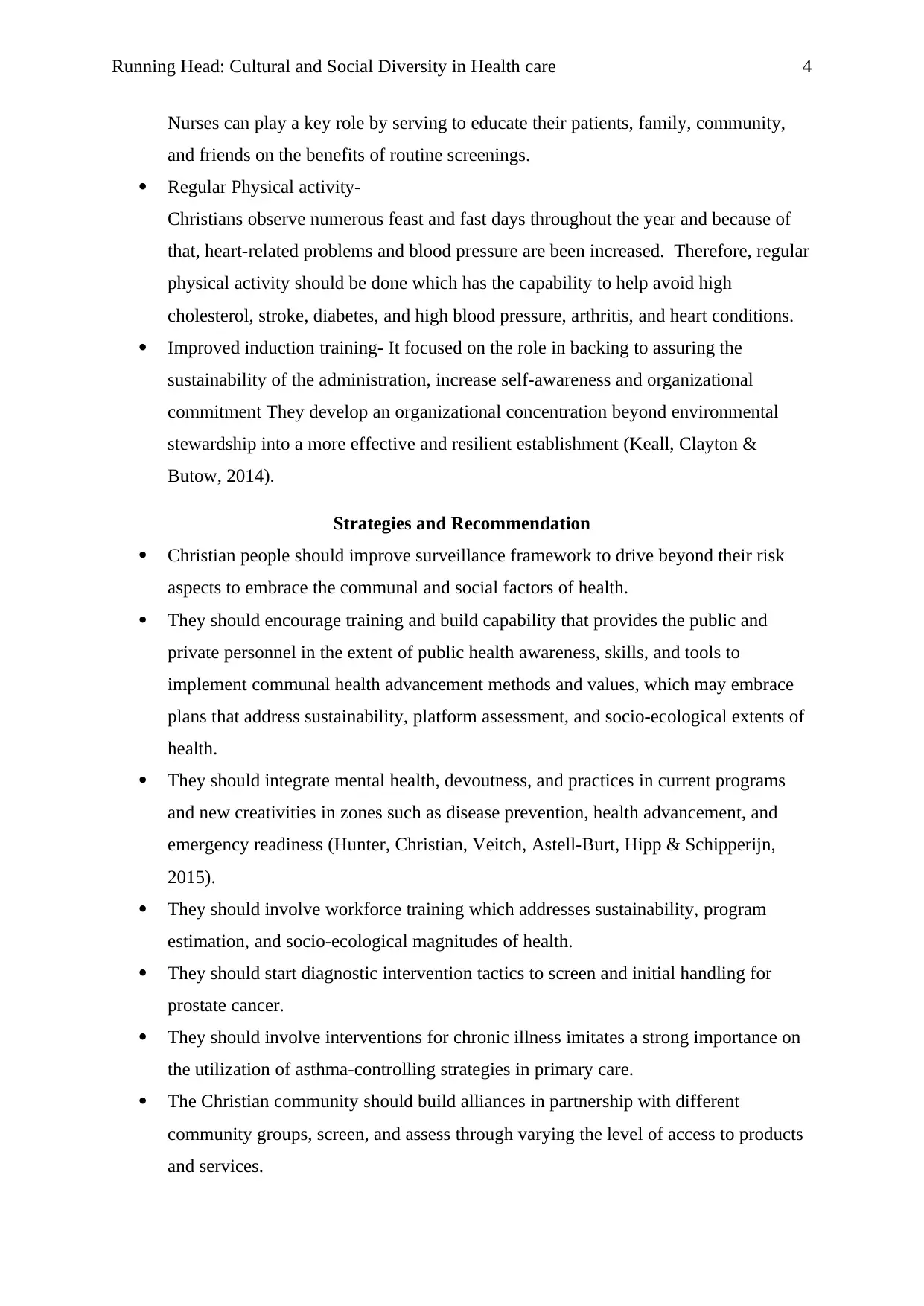
Running Head: Cultural and Social Diversity in Health care 4
Nurses can play a key role by serving to educate their patients, family, community,
and friends on the benefits of routine screenings.
Regular Physical activity-
Christians observe numerous feast and fast days throughout the year and because of
that, heart-related problems and blood pressure are been increased. Therefore, regular
physical activity should be done which has the capability to help avoid high
cholesterol, stroke, diabetes, and high blood pressure, arthritis, and heart conditions.
Improved induction training- It focused on the role in backing to assuring the
sustainability of the administration, increase self-awareness and organizational
commitment They develop an organizational concentration beyond environmental
stewardship into a more effective and resilient establishment (Keall, Clayton &
Butow, 2014).
Strategies and Recommendation
Christian people should improve surveillance framework to drive beyond their risk
aspects to embrace the communal and social factors of health.
They should encourage training and build capability that provides the public and
private personnel in the extent of public health awareness, skills, and tools to
implement communal health advancement methods and values, which may embrace
plans that address sustainability, platform assessment, and socio-ecological extents of
health.
They should integrate mental health, devoutness, and practices in current programs
and new creativities in zones such as disease prevention, health advancement, and
emergency readiness (Hunter, Christian, Veitch, Astell-Burt, Hipp & Schipperijn,
2015).
They should involve workforce training which addresses sustainability, program
estimation, and socio-ecological magnitudes of health.
They should start diagnostic intervention tactics to screen and initial handling for
prostate cancer.
They should involve interventions for chronic illness imitates a strong importance on
the utilization of asthma-controlling strategies in primary care.
The Christian community should build alliances in partnership with different
community groups, screen, and assess through varying the level of access to products
and services.
Nurses can play a key role by serving to educate their patients, family, community,
and friends on the benefits of routine screenings.
Regular Physical activity-
Christians observe numerous feast and fast days throughout the year and because of
that, heart-related problems and blood pressure are been increased. Therefore, regular
physical activity should be done which has the capability to help avoid high
cholesterol, stroke, diabetes, and high blood pressure, arthritis, and heart conditions.
Improved induction training- It focused on the role in backing to assuring the
sustainability of the administration, increase self-awareness and organizational
commitment They develop an organizational concentration beyond environmental
stewardship into a more effective and resilient establishment (Keall, Clayton &
Butow, 2014).
Strategies and Recommendation
Christian people should improve surveillance framework to drive beyond their risk
aspects to embrace the communal and social factors of health.
They should encourage training and build capability that provides the public and
private personnel in the extent of public health awareness, skills, and tools to
implement communal health advancement methods and values, which may embrace
plans that address sustainability, platform assessment, and socio-ecological extents of
health.
They should integrate mental health, devoutness, and practices in current programs
and new creativities in zones such as disease prevention, health advancement, and
emergency readiness (Hunter, Christian, Veitch, Astell-Burt, Hipp & Schipperijn,
2015).
They should involve workforce training which addresses sustainability, program
estimation, and socio-ecological magnitudes of health.
They should start diagnostic intervention tactics to screen and initial handling for
prostate cancer.
They should involve interventions for chronic illness imitates a strong importance on
the utilization of asthma-controlling strategies in primary care.
The Christian community should build alliances in partnership with different
community groups, screen, and assess through varying the level of access to products
and services.
Secure Best Marks with AI Grader
Need help grading? Try our AI Grader for instant feedback on your assignments.
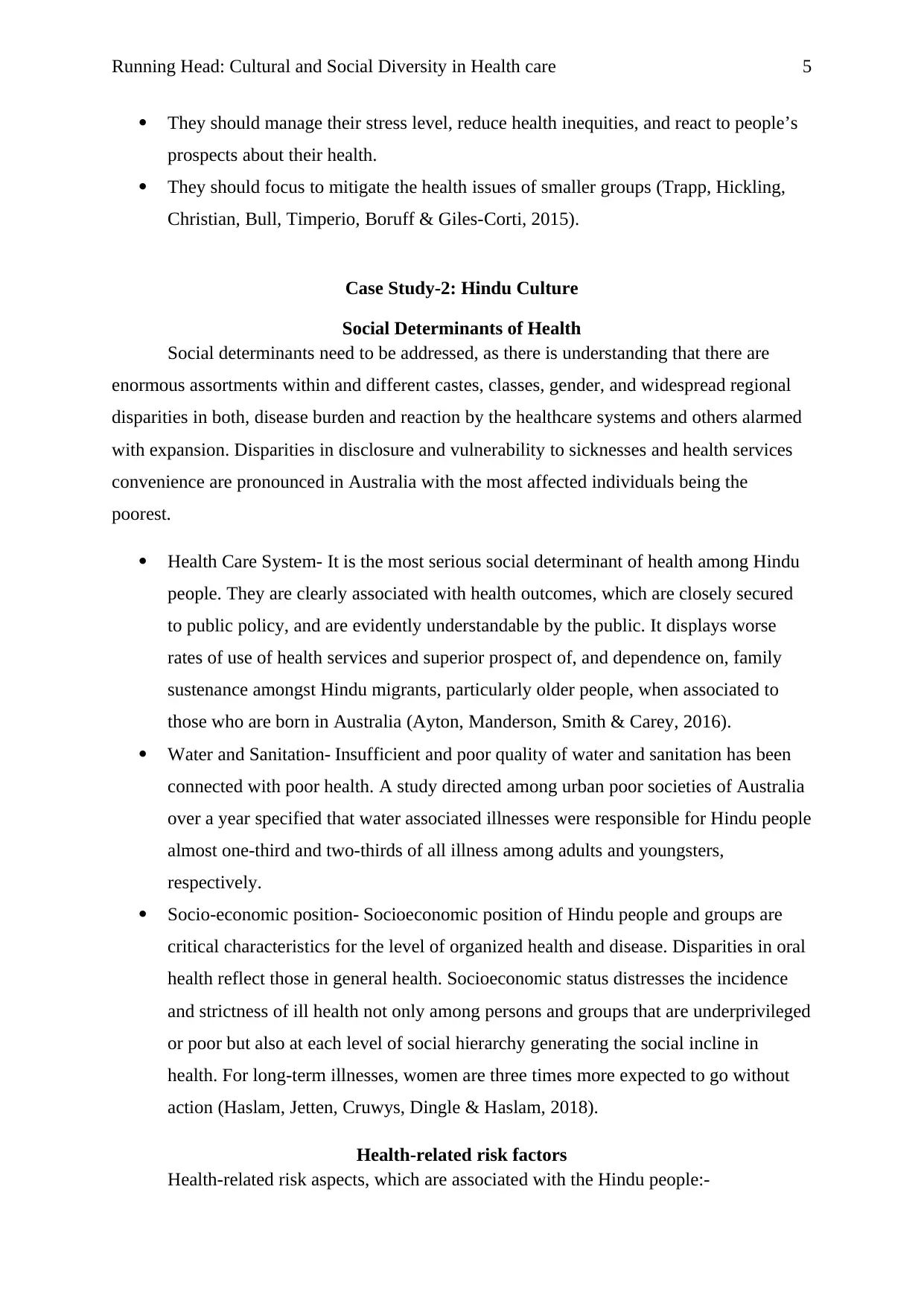
Running Head: Cultural and Social Diversity in Health care 5
They should manage their stress level, reduce health inequities, and react to people’s
prospects about their health.
They should focus to mitigate the health issues of smaller groups (Trapp, Hickling,
Christian, Bull, Timperio, Boruff & Giles-Corti, 2015).
Case Study-2: Hindu Culture
Social Determinants of Health
Social determinants need to be addressed, as there is understanding that there are
enormous assortments within and different castes, classes, gender, and widespread regional
disparities in both, disease burden and reaction by the healthcare systems and others alarmed
with expansion. Disparities in disclosure and vulnerability to sicknesses and health services
convenience are pronounced in Australia with the most affected individuals being the
poorest.
Health Care System- It is the most serious social determinant of health among Hindu
people. They are clearly associated with health outcomes, which are closely secured
to public policy, and are evidently understandable by the public. It displays worse
rates of use of health services and superior prospect of, and dependence on, family
sustenance amongst Hindu migrants, particularly older people, when associated to
those who are born in Australia (Ayton, Manderson, Smith & Carey, 2016).
Water and Sanitation- Insufficient and poor quality of water and sanitation has been
connected with poor health. A study directed among urban poor societies of Australia
over a year specified that water associated illnesses were responsible for Hindu people
almost one-third and two-thirds of all illness among adults and youngsters,
respectively.
Socio-economic position- Socioeconomic position of Hindu people and groups are
critical characteristics for the level of organized health and disease. Disparities in oral
health reflect those in general health. Socioeconomic status distresses the incidence
and strictness of ill health not only among persons and groups that are underprivileged
or poor but also at each level of social hierarchy generating the social incline in
health. For long-term illnesses, women are three times more expected to go without
action (Haslam, Jetten, Cruwys, Dingle & Haslam, 2018).
Health-related risk factors
Health-related risk aspects, which are associated with the Hindu people:-
They should manage their stress level, reduce health inequities, and react to people’s
prospects about their health.
They should focus to mitigate the health issues of smaller groups (Trapp, Hickling,
Christian, Bull, Timperio, Boruff & Giles-Corti, 2015).
Case Study-2: Hindu Culture
Social Determinants of Health
Social determinants need to be addressed, as there is understanding that there are
enormous assortments within and different castes, classes, gender, and widespread regional
disparities in both, disease burden and reaction by the healthcare systems and others alarmed
with expansion. Disparities in disclosure and vulnerability to sicknesses and health services
convenience are pronounced in Australia with the most affected individuals being the
poorest.
Health Care System- It is the most serious social determinant of health among Hindu
people. They are clearly associated with health outcomes, which are closely secured
to public policy, and are evidently understandable by the public. It displays worse
rates of use of health services and superior prospect of, and dependence on, family
sustenance amongst Hindu migrants, particularly older people, when associated to
those who are born in Australia (Ayton, Manderson, Smith & Carey, 2016).
Water and Sanitation- Insufficient and poor quality of water and sanitation has been
connected with poor health. A study directed among urban poor societies of Australia
over a year specified that water associated illnesses were responsible for Hindu people
almost one-third and two-thirds of all illness among adults and youngsters,
respectively.
Socio-economic position- Socioeconomic position of Hindu people and groups are
critical characteristics for the level of organized health and disease. Disparities in oral
health reflect those in general health. Socioeconomic status distresses the incidence
and strictness of ill health not only among persons and groups that are underprivileged
or poor but also at each level of social hierarchy generating the social incline in
health. For long-term illnesses, women are three times more expected to go without
action (Haslam, Jetten, Cruwys, Dingle & Haslam, 2018).
Health-related risk factors
Health-related risk aspects, which are associated with the Hindu people:-

Running Head: Cultural and Social Diversity in Health care 6
Genetic risk factors incorporate the lifestyle sicknesses, which are more common in
Australia, and people are normally much poorer. The diseases that are most
contaminated are called Non-Communicable diseases. These NCD's embrace heart
diseases, diabetes, and cancer. The reason that these sicknesses are so common and so
fatal is that they do not take their health seriously.
Mental health risk factors involve mental disorders as a shared form of disability in
Hindu people identifies the conditions such as schizophrenia, mental retardation,
depressive and persistent mood disorders can enforce a marked illness burden on
Hindu people (Fernandez, Rolley, Rajaratnam, Everett & Davidson, 2015).
Environmental related risk factors include the living situations, which can be very
severe and unsanitary, as it is unusual to own cleaning provisions such as Windex or
vacuum cleaners. The lack of clean air, clothing, and a fresh living space generates
harmful microorganisms revealed that the main reason for these illnesses is so
predominant.
Psychological related risk factors involve the occurrence of risk factors for coronary
heart illness, such as hypertension, obesity; diabetes was significantly higher in Hindu
people as they take so much tension and stress because of their family and children
health and well-being. This leads to hypertension and heart problems.
The most common health-related factors embrace heart diseases and smoking which
is very common among Hindu people. It is usually caused by the level of obesity in this
culture, which includes eating habits as they eat lots of cheese, foods rich in fats and very late
dinner. This is directly prominent to abdominal obesity, which contributes to heart diseases.
In this culture, smoking and hookah are very common which causes cancer, lung diseases,
and many more (Khawaja, Allan & Schweitzer, 2018).
Strategies for the provision of health care
Social stratification- Changing lifestyle might appear to be the easiest and cheapest
way of safeguarding health improvement in a society at any level of expansion. If
people learned to transform the way of life in the society and grow the most
nourishing diet, which is inside their means, health position would show a notable
development (Peek, Carey, Mackenzie & Sanson‐Fisher, 2017). Hindu people should
not smoke, take alcohol in access, which enables safety conscious on the roads and at
work, a large volume of illness and death could be avoided.
Genetic risk factors incorporate the lifestyle sicknesses, which are more common in
Australia, and people are normally much poorer. The diseases that are most
contaminated are called Non-Communicable diseases. These NCD's embrace heart
diseases, diabetes, and cancer. The reason that these sicknesses are so common and so
fatal is that they do not take their health seriously.
Mental health risk factors involve mental disorders as a shared form of disability in
Hindu people identifies the conditions such as schizophrenia, mental retardation,
depressive and persistent mood disorders can enforce a marked illness burden on
Hindu people (Fernandez, Rolley, Rajaratnam, Everett & Davidson, 2015).
Environmental related risk factors include the living situations, which can be very
severe and unsanitary, as it is unusual to own cleaning provisions such as Windex or
vacuum cleaners. The lack of clean air, clothing, and a fresh living space generates
harmful microorganisms revealed that the main reason for these illnesses is so
predominant.
Psychological related risk factors involve the occurrence of risk factors for coronary
heart illness, such as hypertension, obesity; diabetes was significantly higher in Hindu
people as they take so much tension and stress because of their family and children
health and well-being. This leads to hypertension and heart problems.
The most common health-related factors embrace heart diseases and smoking which
is very common among Hindu people. It is usually caused by the level of obesity in this
culture, which includes eating habits as they eat lots of cheese, foods rich in fats and very late
dinner. This is directly prominent to abdominal obesity, which contributes to heart diseases.
In this culture, smoking and hookah are very common which causes cancer, lung diseases,
and many more (Khawaja, Allan & Schweitzer, 2018).
Strategies for the provision of health care
Social stratification- Changing lifestyle might appear to be the easiest and cheapest
way of safeguarding health improvement in a society at any level of expansion. If
people learned to transform the way of life in the society and grow the most
nourishing diet, which is inside their means, health position would show a notable
development (Peek, Carey, Mackenzie & Sanson‐Fisher, 2017). Hindu people should
not smoke, take alcohol in access, which enables safety conscious on the roads and at
work, a large volume of illness and death could be avoided.
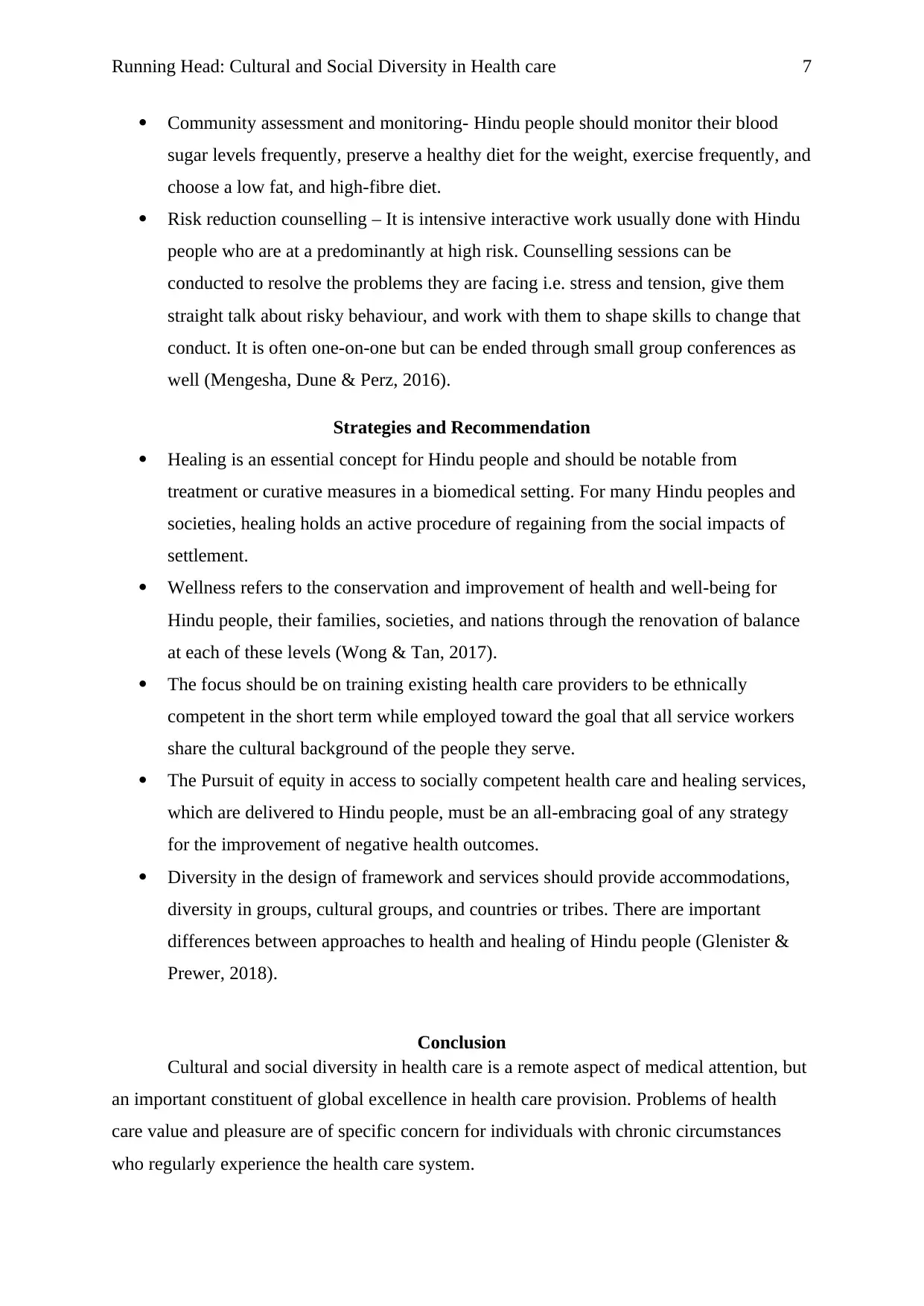
Running Head: Cultural and Social Diversity in Health care 7
Community assessment and monitoring- Hindu people should monitor their blood
sugar levels frequently, preserve a healthy diet for the weight, exercise frequently, and
choose a low fat, and high-fibre diet.
Risk reduction counselling – It is intensive interactive work usually done with Hindu
people who are at a predominantly at high risk. Counselling sessions can be
conducted to resolve the problems they are facing i.e. stress and tension, give them
straight talk about risky behaviour, and work with them to shape skills to change that
conduct. It is often one-on-one but can be ended through small group conferences as
well (Mengesha, Dune & Perz, 2016).
Strategies and Recommendation
Healing is an essential concept for Hindu people and should be notable from
treatment or curative measures in a biomedical setting. For many Hindu peoples and
societies, healing holds an active procedure of regaining from the social impacts of
settlement.
Wellness refers to the conservation and improvement of health and well-being for
Hindu people, their families, societies, and nations through the renovation of balance
at each of these levels (Wong & Tan, 2017).
The focus should be on training existing health care providers to be ethnically
competent in the short term while employed toward the goal that all service workers
share the cultural background of the people they serve.
The Pursuit of equity in access to socially competent health care and healing services,
which are delivered to Hindu people, must be an all-embracing goal of any strategy
for the improvement of negative health outcomes.
Diversity in the design of framework and services should provide accommodations,
diversity in groups, cultural groups, and countries or tribes. There are important
differences between approaches to health and healing of Hindu people (Glenister &
Prewer, 2018).
Conclusion
Cultural and social diversity in health care is a remote aspect of medical attention, but
an important constituent of global excellence in health care provision. Problems of health
care value and pleasure are of specific concern for individuals with chronic circumstances
who regularly experience the health care system.
Community assessment and monitoring- Hindu people should monitor their blood
sugar levels frequently, preserve a healthy diet for the weight, exercise frequently, and
choose a low fat, and high-fibre diet.
Risk reduction counselling – It is intensive interactive work usually done with Hindu
people who are at a predominantly at high risk. Counselling sessions can be
conducted to resolve the problems they are facing i.e. stress and tension, give them
straight talk about risky behaviour, and work with them to shape skills to change that
conduct. It is often one-on-one but can be ended through small group conferences as
well (Mengesha, Dune & Perz, 2016).
Strategies and Recommendation
Healing is an essential concept for Hindu people and should be notable from
treatment or curative measures in a biomedical setting. For many Hindu peoples and
societies, healing holds an active procedure of regaining from the social impacts of
settlement.
Wellness refers to the conservation and improvement of health and well-being for
Hindu people, their families, societies, and nations through the renovation of balance
at each of these levels (Wong & Tan, 2017).
The focus should be on training existing health care providers to be ethnically
competent in the short term while employed toward the goal that all service workers
share the cultural background of the people they serve.
The Pursuit of equity in access to socially competent health care and healing services,
which are delivered to Hindu people, must be an all-embracing goal of any strategy
for the improvement of negative health outcomes.
Diversity in the design of framework and services should provide accommodations,
diversity in groups, cultural groups, and countries or tribes. There are important
differences between approaches to health and healing of Hindu people (Glenister &
Prewer, 2018).
Conclusion
Cultural and social diversity in health care is a remote aspect of medical attention, but
an important constituent of global excellence in health care provision. Problems of health
care value and pleasure are of specific concern for individuals with chronic circumstances
who regularly experience the health care system.
Paraphrase This Document
Need a fresh take? Get an instant paraphrase of this document with our AI Paraphraser
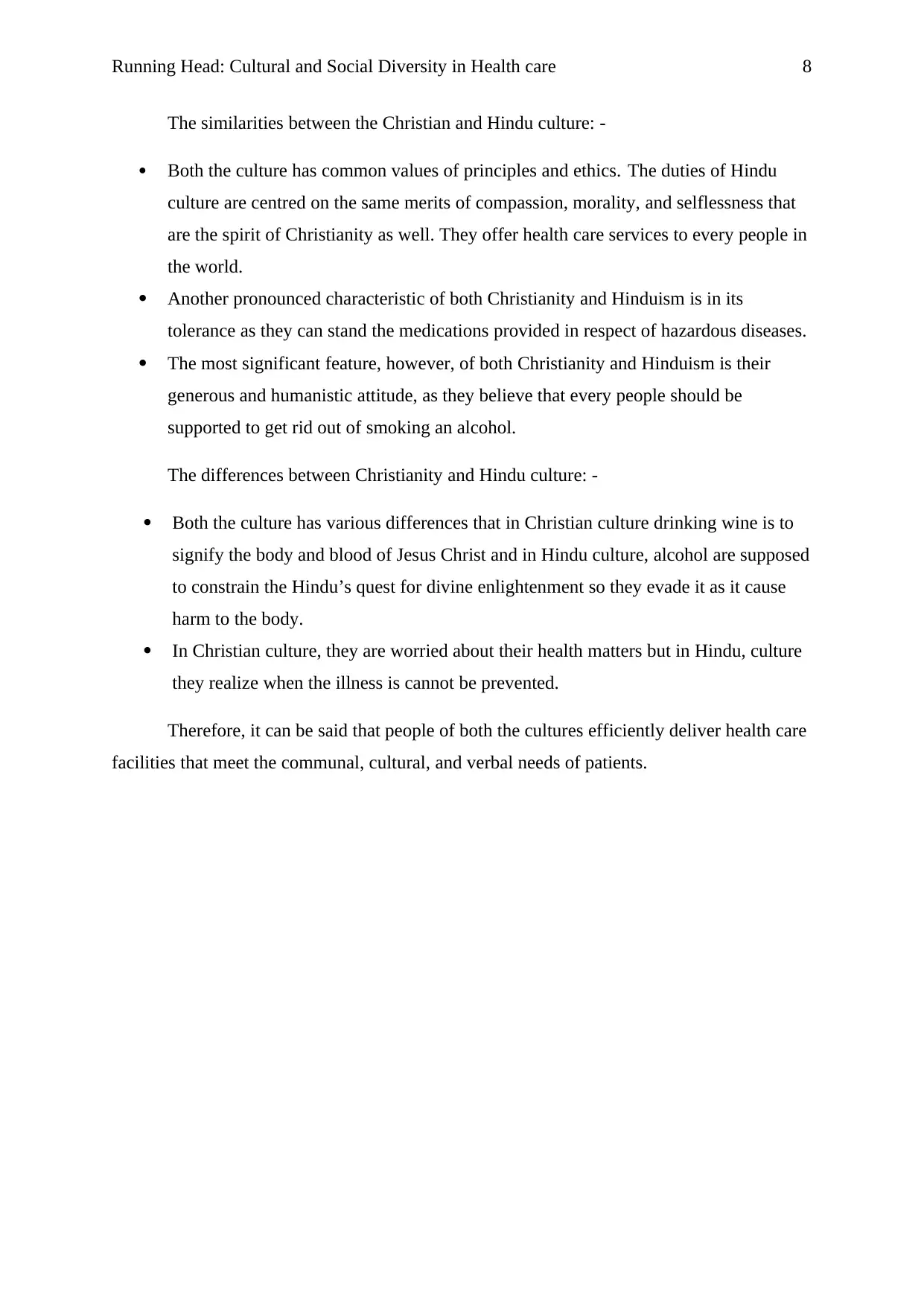
Running Head: Cultural and Social Diversity in Health care 8
The similarities between the Christian and Hindu culture: -
Both the culture has common values of principles and ethics. The duties of Hindu
culture are centred on the same merits of compassion, morality, and selflessness that
are the spirit of Christianity as well. They offer health care services to every people in
the world.
Another pronounced characteristic of both Christianity and Hinduism is in its
tolerance as they can stand the medications provided in respect of hazardous diseases.
The most significant feature, however, of both Christianity and Hinduism is their
generous and humanistic attitude, as they believe that every people should be
supported to get rid out of smoking an alcohol.
The differences between Christianity and Hindu culture: -
Both the culture has various differences that in Christian culture drinking wine is to
signify the body and blood of Jesus Christ and in Hindu culture, alcohol are supposed
to constrain the Hindu’s quest for divine enlightenment so they evade it as it cause
harm to the body.
In Christian culture, they are worried about their health matters but in Hindu, culture
they realize when the illness is cannot be prevented.
Therefore, it can be said that people of both the cultures efficiently deliver health care
facilities that meet the communal, cultural, and verbal needs of patients.
The similarities between the Christian and Hindu culture: -
Both the culture has common values of principles and ethics. The duties of Hindu
culture are centred on the same merits of compassion, morality, and selflessness that
are the spirit of Christianity as well. They offer health care services to every people in
the world.
Another pronounced characteristic of both Christianity and Hinduism is in its
tolerance as they can stand the medications provided in respect of hazardous diseases.
The most significant feature, however, of both Christianity and Hinduism is their
generous and humanistic attitude, as they believe that every people should be
supported to get rid out of smoking an alcohol.
The differences between Christianity and Hindu culture: -
Both the culture has various differences that in Christian culture drinking wine is to
signify the body and blood of Jesus Christ and in Hindu culture, alcohol are supposed
to constrain the Hindu’s quest for divine enlightenment so they evade it as it cause
harm to the body.
In Christian culture, they are worried about their health matters but in Hindu, culture
they realize when the illness is cannot be prevented.
Therefore, it can be said that people of both the cultures efficiently deliver health care
facilities that meet the communal, cultural, and verbal needs of patients.
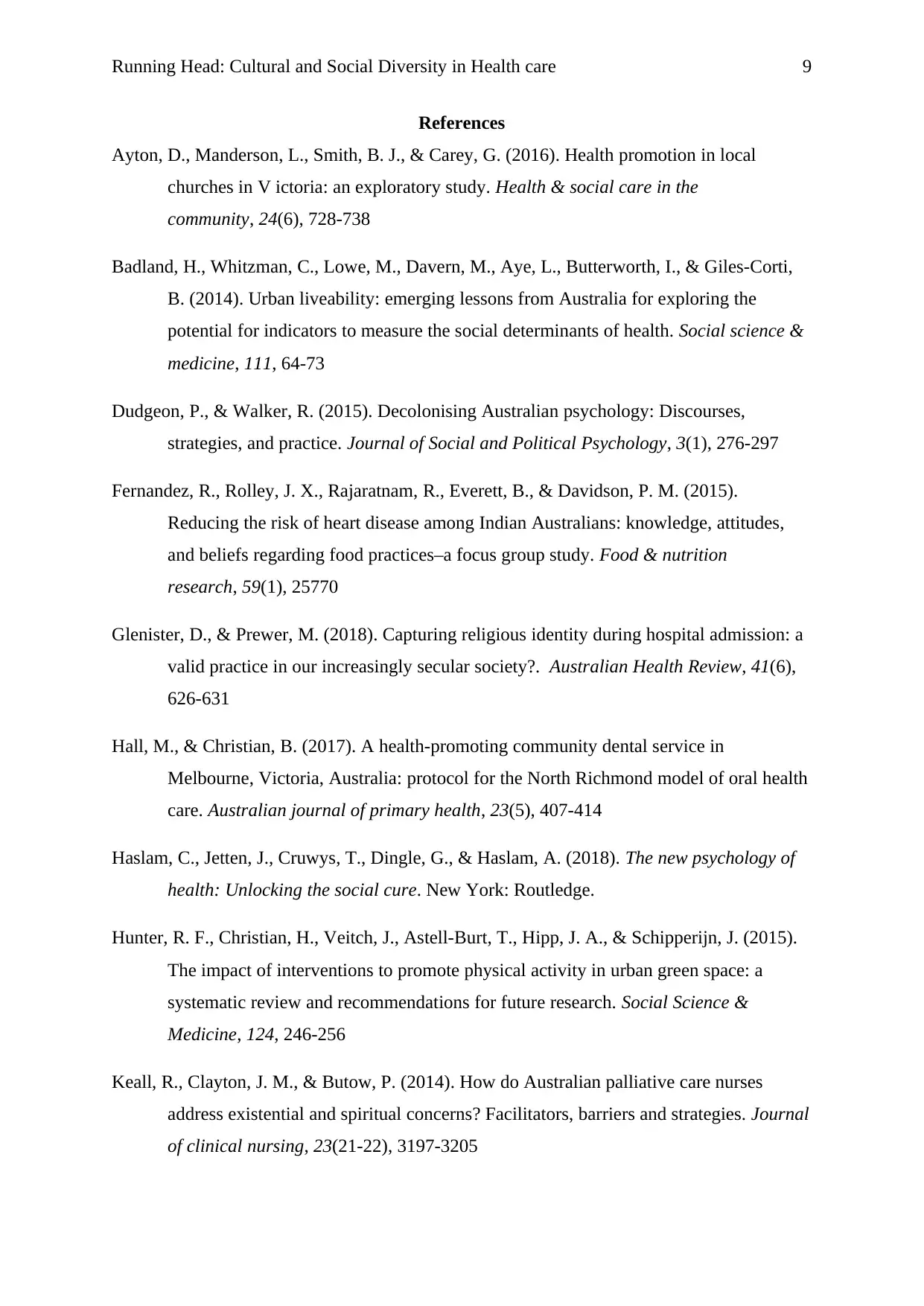
Running Head: Cultural and Social Diversity in Health care 9
References
Ayton, D., Manderson, L., Smith, B. J., & Carey, G. (2016). Health promotion in local
churches in V ictoria: an exploratory study. Health & social care in the
community, 24(6), 728-738
Badland, H., Whitzman, C., Lowe, M., Davern, M., Aye, L., Butterworth, I., & Giles-Corti,
B. (2014). Urban liveability: emerging lessons from Australia for exploring the
potential for indicators to measure the social determinants of health. Social science &
medicine, 111, 64-73
Dudgeon, P., & Walker, R. (2015). Decolonising Australian psychology: Discourses,
strategies, and practice. Journal of Social and Political Psychology, 3(1), 276-297
Fernandez, R., Rolley, J. X., Rajaratnam, R., Everett, B., & Davidson, P. M. (2015).
Reducing the risk of heart disease among Indian Australians: knowledge, attitudes,
and beliefs regarding food practices–a focus group study. Food & nutrition
research, 59(1), 25770
Glenister, D., & Prewer, M. (2018). Capturing religious identity during hospital admission: a
valid practice in our increasingly secular society?. Australian Health Review, 41(6),
626-631
Hall, M., & Christian, B. (2017). A health-promoting community dental service in
Melbourne, Victoria, Australia: protocol for the North Richmond model of oral health
care. Australian journal of primary health, 23(5), 407-414
Haslam, C., Jetten, J., Cruwys, T., Dingle, G., & Haslam, A. (2018). The new psychology of
health: Unlocking the social cure. New York: Routledge.
Hunter, R. F., Christian, H., Veitch, J., Astell-Burt, T., Hipp, J. A., & Schipperijn, J. (2015).
The impact of interventions to promote physical activity in urban green space: a
systematic review and recommendations for future research. Social Science &
Medicine, 124, 246-256
Keall, R., Clayton, J. M., & Butow, P. (2014). How do Australian palliative care nurses
address existential and spiritual concerns? Facilitators, barriers and strategies. Journal
of clinical nursing, 23(21-22), 3197-3205
References
Ayton, D., Manderson, L., Smith, B. J., & Carey, G. (2016). Health promotion in local
churches in V ictoria: an exploratory study. Health & social care in the
community, 24(6), 728-738
Badland, H., Whitzman, C., Lowe, M., Davern, M., Aye, L., Butterworth, I., & Giles-Corti,
B. (2014). Urban liveability: emerging lessons from Australia for exploring the
potential for indicators to measure the social determinants of health. Social science &
medicine, 111, 64-73
Dudgeon, P., & Walker, R. (2015). Decolonising Australian psychology: Discourses,
strategies, and practice. Journal of Social and Political Psychology, 3(1), 276-297
Fernandez, R., Rolley, J. X., Rajaratnam, R., Everett, B., & Davidson, P. M. (2015).
Reducing the risk of heart disease among Indian Australians: knowledge, attitudes,
and beliefs regarding food practices–a focus group study. Food & nutrition
research, 59(1), 25770
Glenister, D., & Prewer, M. (2018). Capturing religious identity during hospital admission: a
valid practice in our increasingly secular society?. Australian Health Review, 41(6),
626-631
Hall, M., & Christian, B. (2017). A health-promoting community dental service in
Melbourne, Victoria, Australia: protocol for the North Richmond model of oral health
care. Australian journal of primary health, 23(5), 407-414
Haslam, C., Jetten, J., Cruwys, T., Dingle, G., & Haslam, A. (2018). The new psychology of
health: Unlocking the social cure. New York: Routledge.
Hunter, R. F., Christian, H., Veitch, J., Astell-Burt, T., Hipp, J. A., & Schipperijn, J. (2015).
The impact of interventions to promote physical activity in urban green space: a
systematic review and recommendations for future research. Social Science &
Medicine, 124, 246-256
Keall, R., Clayton, J. M., & Butow, P. (2014). How do Australian palliative care nurses
address existential and spiritual concerns? Facilitators, barriers and strategies. Journal
of clinical nursing, 23(21-22), 3197-3205
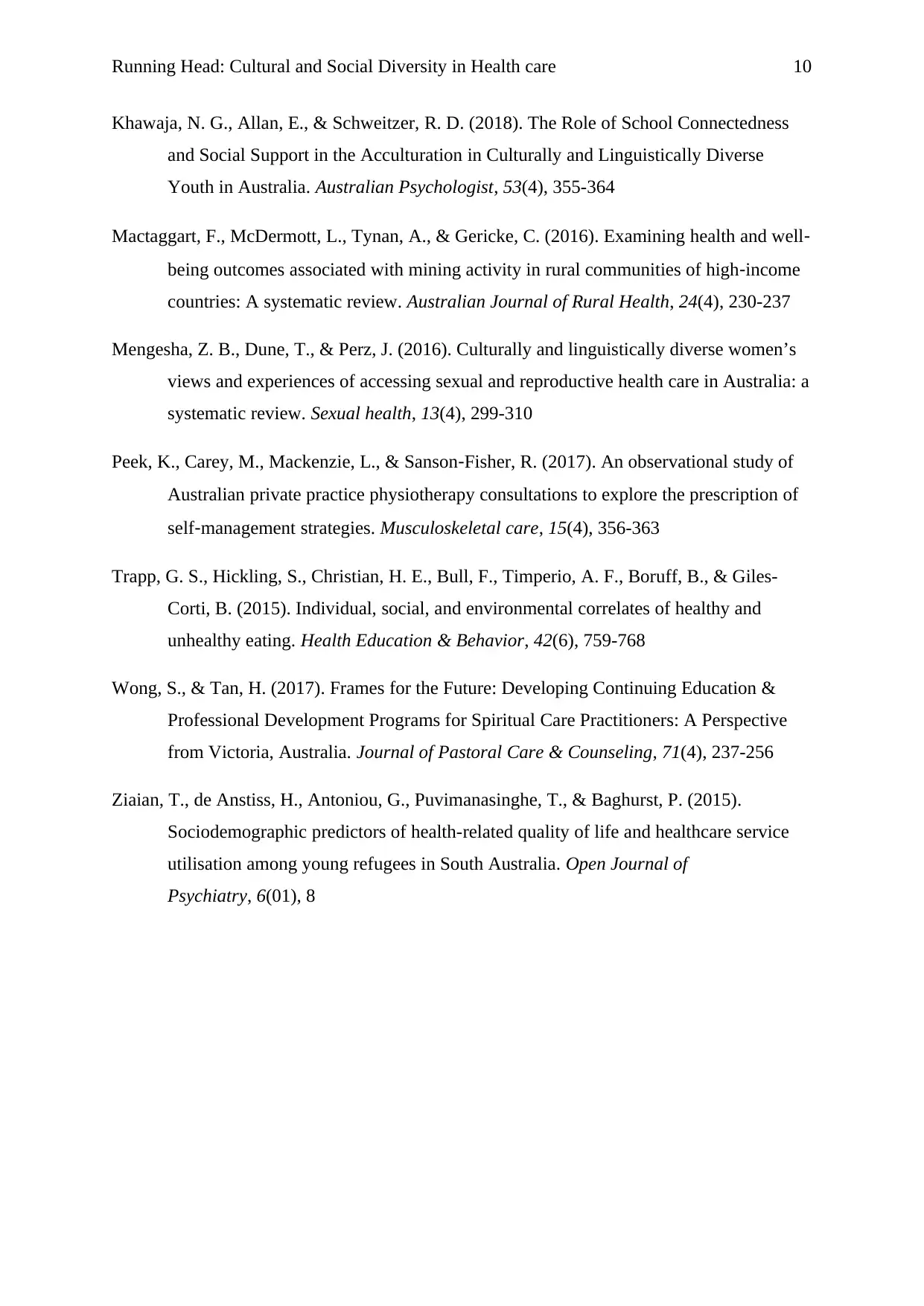
Running Head: Cultural and Social Diversity in Health care 10
Khawaja, N. G., Allan, E., & Schweitzer, R. D. (2018). The Role of School Connectedness
and Social Support in the Acculturation in Culturally and Linguistically Diverse
Youth in Australia. Australian Psychologist, 53(4), 355-364
Mactaggart, F., McDermott, L., Tynan, A., & Gericke, C. (2016). Examining health and well‐
being outcomes associated with mining activity in rural communities of high‐income
countries: A systematic review. Australian Journal of Rural Health, 24(4), 230-237
Mengesha, Z. B., Dune, T., & Perz, J. (2016). Culturally and linguistically diverse women’s
views and experiences of accessing sexual and reproductive health care in Australia: a
systematic review. Sexual health, 13(4), 299-310
Peek, K., Carey, M., Mackenzie, L., & Sanson‐Fisher, R. (2017). An observational study of
Australian private practice physiotherapy consultations to explore the prescription of
self‐management strategies. Musculoskeletal care, 15(4), 356-363
Trapp, G. S., Hickling, S., Christian, H. E., Bull, F., Timperio, A. F., Boruff, B., & Giles-
Corti, B. (2015). Individual, social, and environmental correlates of healthy and
unhealthy eating. Health Education & Behavior, 42(6), 759-768
Wong, S., & Tan, H. (2017). Frames for the Future: Developing Continuing Education &
Professional Development Programs for Spiritual Care Practitioners: A Perspective
from Victoria, Australia. Journal of Pastoral Care & Counseling, 71(4), 237-256
Ziaian, T., de Anstiss, H., Antoniou, G., Puvimanasinghe, T., & Baghurst, P. (2015).
Sociodemographic predictors of health-related quality of life and healthcare service
utilisation among young refugees in South Australia. Open Journal of
Psychiatry, 6(01), 8
Khawaja, N. G., Allan, E., & Schweitzer, R. D. (2018). The Role of School Connectedness
and Social Support in the Acculturation in Culturally and Linguistically Diverse
Youth in Australia. Australian Psychologist, 53(4), 355-364
Mactaggart, F., McDermott, L., Tynan, A., & Gericke, C. (2016). Examining health and well‐
being outcomes associated with mining activity in rural communities of high‐income
countries: A systematic review. Australian Journal of Rural Health, 24(4), 230-237
Mengesha, Z. B., Dune, T., & Perz, J. (2016). Culturally and linguistically diverse women’s
views and experiences of accessing sexual and reproductive health care in Australia: a
systematic review. Sexual health, 13(4), 299-310
Peek, K., Carey, M., Mackenzie, L., & Sanson‐Fisher, R. (2017). An observational study of
Australian private practice physiotherapy consultations to explore the prescription of
self‐management strategies. Musculoskeletal care, 15(4), 356-363
Trapp, G. S., Hickling, S., Christian, H. E., Bull, F., Timperio, A. F., Boruff, B., & Giles-
Corti, B. (2015). Individual, social, and environmental correlates of healthy and
unhealthy eating. Health Education & Behavior, 42(6), 759-768
Wong, S., & Tan, H. (2017). Frames for the Future: Developing Continuing Education &
Professional Development Programs for Spiritual Care Practitioners: A Perspective
from Victoria, Australia. Journal of Pastoral Care & Counseling, 71(4), 237-256
Ziaian, T., de Anstiss, H., Antoniou, G., Puvimanasinghe, T., & Baghurst, P. (2015).
Sociodemographic predictors of health-related quality of life and healthcare service
utilisation among young refugees in South Australia. Open Journal of
Psychiatry, 6(01), 8
Secure Best Marks with AI Grader
Need help grading? Try our AI Grader for instant feedback on your assignments.
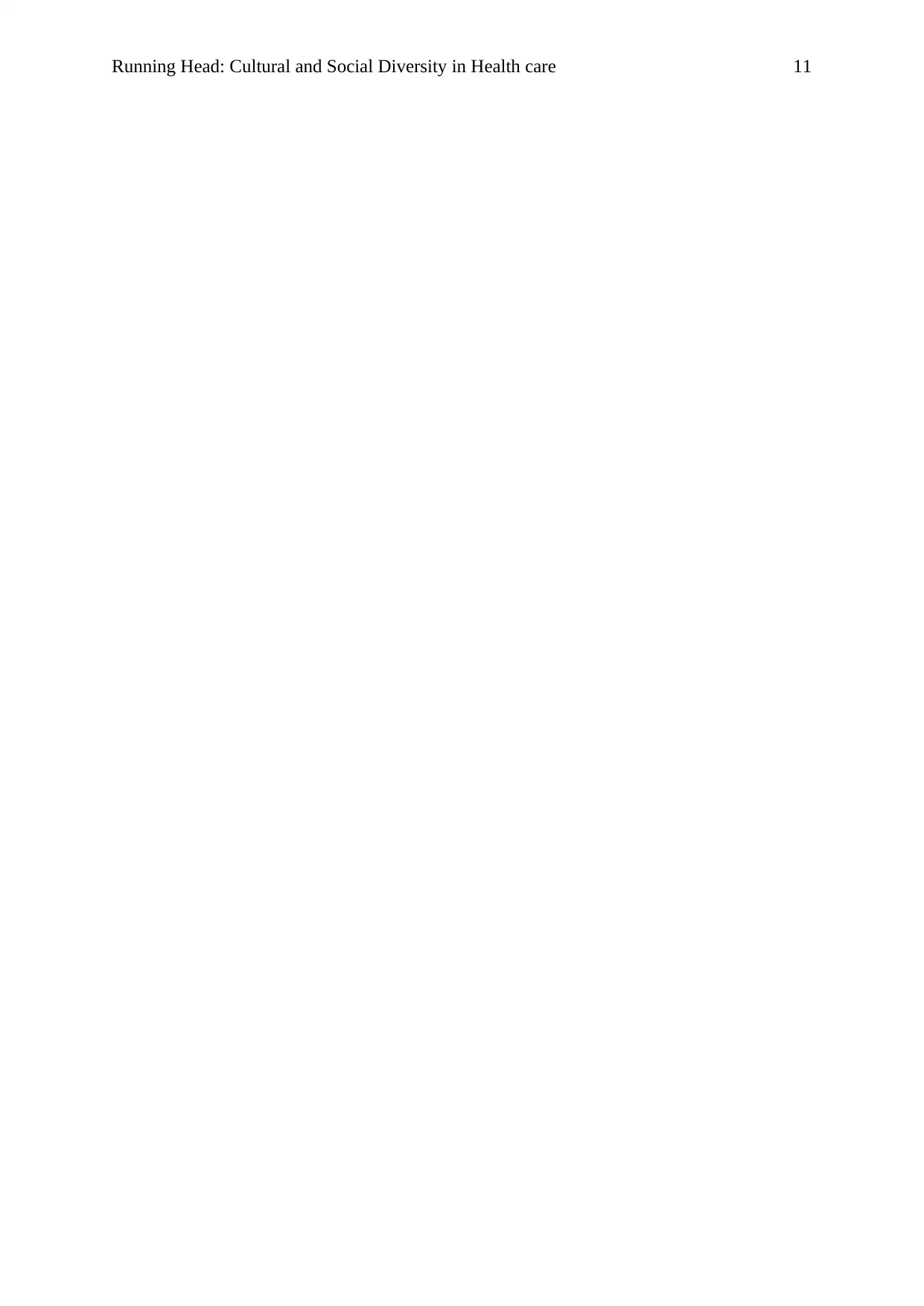
Running Head: Cultural and Social Diversity in Health care 11
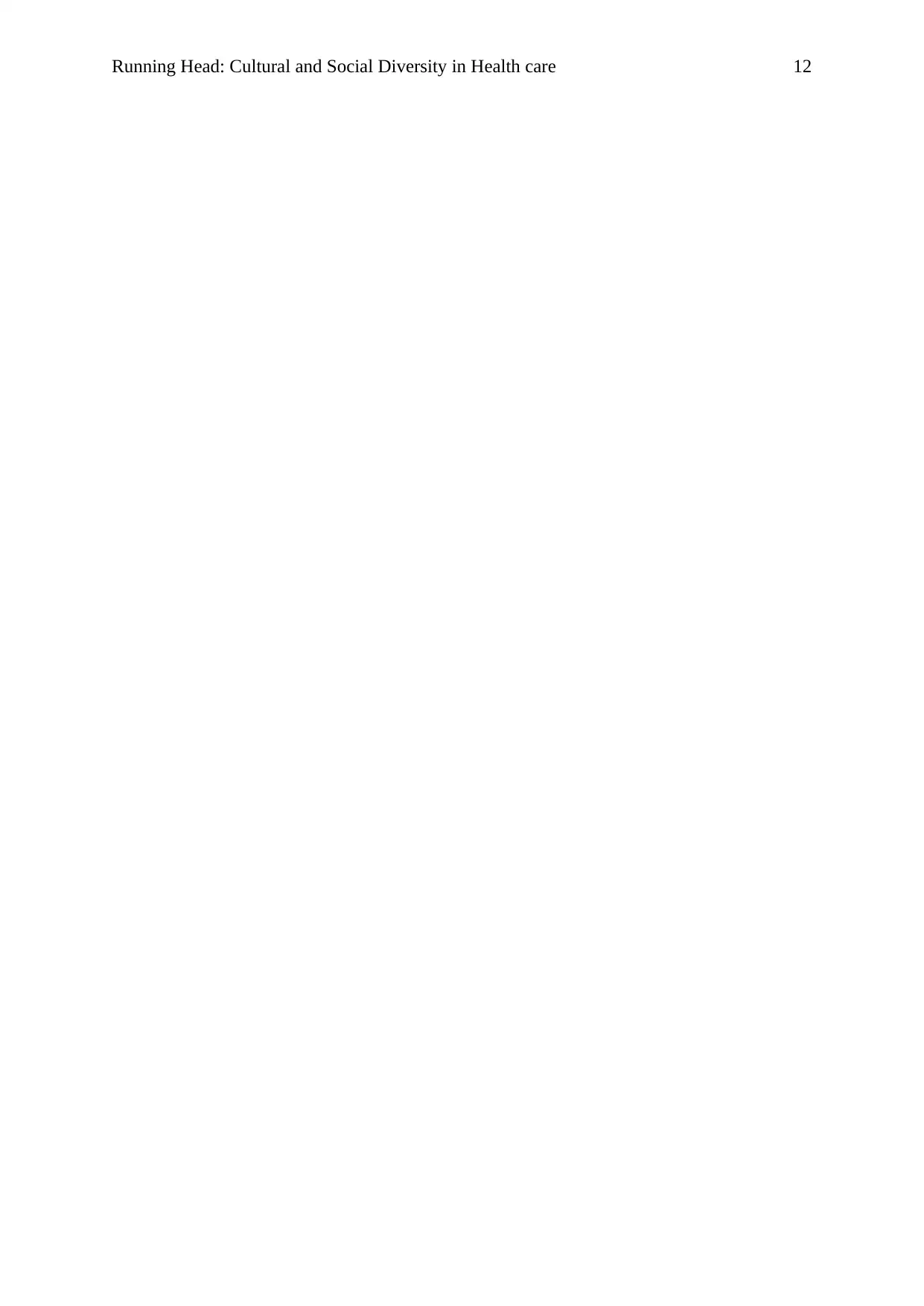
Running Head: Cultural and Social Diversity in Health care 12
1 out of 12
Related Documents
Your All-in-One AI-Powered Toolkit for Academic Success.
+13062052269
info@desklib.com
Available 24*7 on WhatsApp / Email
![[object Object]](/_next/static/media/star-bottom.7253800d.svg)
Unlock your academic potential
© 2024 | Zucol Services PVT LTD | All rights reserved.





